Poorest students still bearing the brunt of debt burden

The Student Awards Agency Scotland (SAAS) has today released a new statistical report, ‘Higher Education Student Support in Scotland’. This is an annual report, detailing a range of statistics and information around the numbers of students receiving support in Scotland, and the amounts they receive.
Key findings from the 2017/18 report include:
- The number of students receiving non-repayable bursaries and grants increased slightly, by 2.8% – 53,620 receiving £76.3 million support in 2017-18 (compared to 52,165 and £70.1 million in 2016-17)
- The average bursary for students from the lowest income backgrounds was up very slightly from £1,400 last year to £1,480 this year.
- The poorest students continue to take on the highest loans, at £5,780 per year for the lowest household income bracket compared to £4,940 for the highest. For a student on a four-year degree course this would add up to £23,120 of debt.
- The total amount authorised in loans was £528.4 million in 2017-18 at an average of £5,290 per student (£5,280 in 2016-17)
NUS Scotland President Liam McCabe said:
“Today’s figures show a slight increase in the overall number of students receiving non-repayable support and students from the poorest backgrounds on average receiving marginally more money. While this modest increase is welcome, there is much more to do to reverse historic decline in levels of bursary and tackle mounting student debt.
“With the figures showing students in the lowest household income bracket still finish their course with the most debt – an eye-watering £23,120 over four years – it is clear the Scottish Government must now focus on improving bursary support available for the poorest students.
“The Scottish Government’s continued commitment to free tuition is appropriate and necessary, but rising living costs make it impossible for students to live on SAAS support alone and increasing uptake of loans means average graduate debt is to reach record highs in coming years. Considering it is the poorest students who are often the most debt adverse, this has the potential to turn many thousands of talented students away from education.
“The Government has stated an ambition to move toward a system where every student receives funding tied to the real living wage – we now need to see a clear plan to achieve this shared goal. NUS Scotland has long outlined the dangers of Scotland’s rising levels of student debt and will work to ensure that increased investment is focused on non-repayable bursary.”












Responses